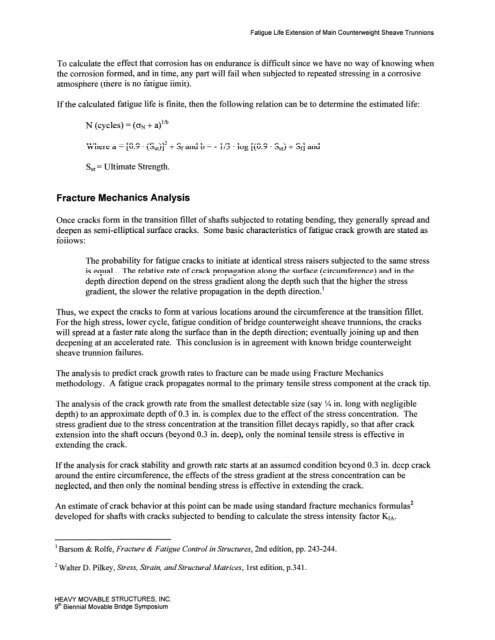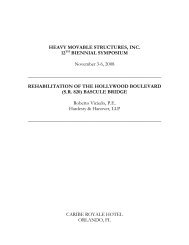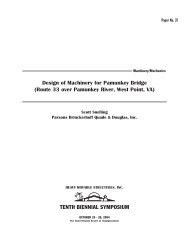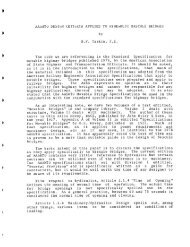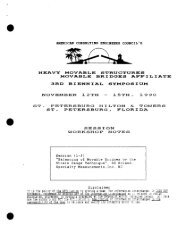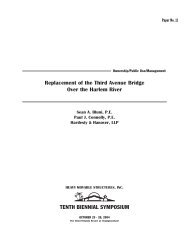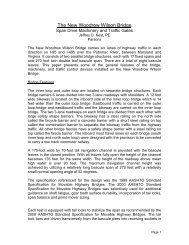Fatigue of Counterweight Sheave Trunnions - Heavy Movable ...
Fatigue of Counterweight Sheave Trunnions - Heavy Movable ...
Fatigue of Counterweight Sheave Trunnions - Heavy Movable ...
Create successful ePaper yourself
Turn your PDF publications into a flip-book with our unique Google optimized e-Paper software.
<strong>Fatigue</strong> Life Extension <strong>of</strong> Main <strong>Counterweight</strong> <strong>Sheave</strong> <strong>Trunnions</strong><br />
To calculate the effect that corrosion has on endurance is difficult since we have no way <strong>of</strong> knowing when<br />
the corrosion formed, and in time, any part will fail when subjected to repeated stressing in a corrosive<br />
atmosphere (there is no fatigue limit).<br />
If the calculated fatigue life is finite, then the following relation can be to determine the estimated life:<br />
N (cycles) = (ON + a)''<br />
Where a = [0.9 (s,,)]* + Sf and b = - 113 . log [(0.9 . S,,) + Sf] and<br />
SUt = Ultimate Strength.<br />
Fracture Mechanics Analysis<br />
Once cracks form in the transition fillet <strong>of</strong> shafts subjected to rotating bending, they generally spread and<br />
deepen as semi-elliptical surface cracks. Some basic characteristics <strong>of</strong> fatigue crack growth are stated as<br />
follows:<br />
The probability for fatigue cracks to initiate at identical stress raisers subjected to the same stress<br />
is equal ... The relative rate <strong>of</strong> crack propagation along the surface (circumference) and in the<br />
depth direction depend on the stress gradient along the depth such that the higher the stress<br />
gradient, the slower the relative propagation in the depth direction.'<br />
Thus, we expect the cracks to form at various locations around the circumference at the transition fillet.<br />
For the high stress, lower cycle, fatigue condition <strong>of</strong> bridge counterweight sheave trunnions, the cracks<br />
will spread at a faster rate along the surface than in the depth direction; eventually joining up and then<br />
deepening at an accelerated rate. This conclusion is in agreement with known bridge counterweight<br />
sheave trunnion failures.<br />
The analysis to predict crack growth rates to fracture can be made using Fracture Mechanics<br />
methodology. A fatigue crack propagates normal to the primary tensile stress component at the crack tip.<br />
The analysis <strong>of</strong> the crack growth rate from the smallest detectable size (say !h in. long with negligible<br />
depth) to an approximate depth <strong>of</strong> 0.3 in. is complex due to the effect <strong>of</strong> the stress concentration. The<br />
stress gradient due to the stress concentration at the transition fillet decays rapidly, so that after crack<br />
extension into the shaft occurs (beyond 0.3 in. deep), only the nominal tensile stress is effective in<br />
extending the crack.<br />
If the analysis for crack stability and growth rate starts at an assumed condition beyond 0.3 in. deep crack<br />
around the entire circumference, the effects <strong>of</strong> the stress gradient at the stress concentration can be<br />
neglected, and then only the nominal bending stress is effective in extending the crack.<br />
An estimate <strong>of</strong> crack behavior at this point can be made using standard fracture mechanics formulas2<br />
developed for shafts with cracks subjected to bending to calculate the stress intensity factor KIA.<br />
-<br />
' Barsom & Rolfe, Fracture & <strong>Fatigue</strong> Control in Structures, 2nd edition, pp. 243-244.<br />
Walter D. Pilkey, Stress, Strain, and Structural Matrices, 1 rst edition, p.34 1.<br />
HEAW MOVABLE STRUCTURES, INC.<br />
gth ~iennial <strong>Movable</strong> Bridge Symposium


